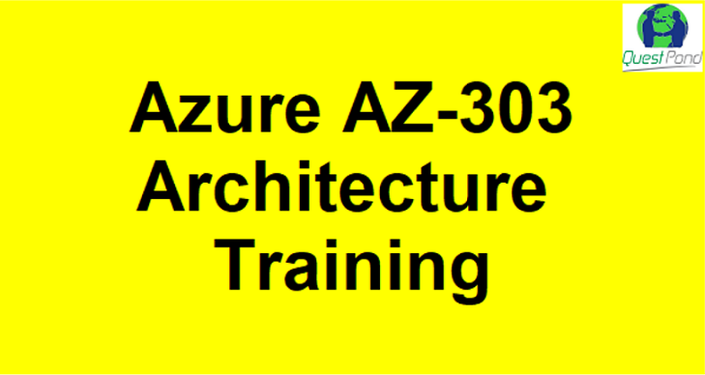
AZ-303 Azure Architecture
|
About QuestPond: It started 15 years back with the one single goal of creating quality step-by-step IT programming-related lessons. We saw many lessons online, either they are done too fast or too slow or are too complicated.
The main goal of QuestPond is to create Step by Step lessons on C#, ASP.NET, Design patterns, SQL, and so on. As years moved on I added other step-by-step lessons like Angular, SharePoint, MSBI, Azure and so on. Azure AZ-303 Architecture Syllabus
Implement cloud infrastructure monitoring
Implement storage accounts
Implement VMs for Windows and Linux
Automate deployment and configuration of resources
Implement virtual networking
Implement Azure Active Directory
Implement and manage hybrid identities
Implement Management and Security Solutions (25-30%)
Implement load balancing and network security
Implement and manage Azure governance solutions
subscriptions and resource groups Manage security for applications
Implement Solutions for Apps (10-15%) Implement an application infrastructure
Implement container-based applications
Implement and Manage Data Platforms (10-15%) Implement NoSQL databases
Implement Azure SQL databases
The exam guide below shows the changes that were implemented on November 24, 2020.
Skills Measured
NOTE: The bullets that appear below each of the skills measured are intended to illustrate how we are assessing that skill. This list is not definitive or exhaustive. NOTE: In most cases, exams do NOT cover preview features, and some features will only be added to an exam when they are GA (General Availability). Implement and Monitor an Azure Infrastructure (50-55%) Implement cloud infrastructure monitoring
initiate automated responses by using Action Groups Implement storage accounts select storage account options based on a use case configure Azure Files and blob storage configure network access to the storage account implement Shared Access Signatures and access policies implement Azure AD authentication for storage manage access keys implement Azure storage replication implement Azure storage account failover Implement VMs for Windows and Linux configure High Availability configure storage for VMs select virtual machine size implement Azure Dedicated Hosts deploy and configure scale sets configure Azure Disk Encryption Automate deployment and configuration of resources save a deployment as an Azure Resource Manager template modify Azure Resource Manager template evaluate location of new resources configure a virtual disk template deploy from a template manage a template library create and execute an automation runbook Implement virtual networking implement VNet to VNet connections implement VNet peering Implement Azure Active Directory add custom domains configure Azure AD Identity Protection implement self-service password reset implement Conditional Access including MFA configure user accounts for MFA configure fraud alerts configure bypass options configure Trusted IPs configure verification methods implement and manage guest accounts manage multiple directories Implement and manage hybrid identities install and configure Azure AD Connect identity synchronization options configure and manage password sync and password writeback configure single sign-on use Azure AD Connect Health Implement Management and Security Solutions (25-30%) Manage workloads in Azure
Implement load balancing and network security
implement Azure Load Balancer implement an application gateway implement a Web Application Firewall implement Azure Firewall implement the Azure Front Door Service implement Azure Traffic Manager implement Network Security Groups and Application Security Groups implement Bastion Implement and manage Azure governance solutions create and manage hierarchical structure that contains management groups, subscriptions and resource groups assign RBAC roles create a custom RBAC role configure access to Azure resources by assigning roles configure management access to Azure interpret effective permissions set up and perform an access review implement and configure an Azure Policy implement and configure an Azure Blueprint Manage security for applications
implement and configure KeyVault implement and configure Azure AD Managed Identities Implement Solutions for Apps (10-15%) Implement an application infrastructure
create and configure Azure App Service create an App Service Web App for Containers create and configure an App Service plan configure an App Service configure networking for an App Service create and manage deployment slots implement Logic Apps implement Azure Functions Implement container-based applications
create a container image configure Azure Kubernetes Service publish and automate image deployment to the Azure Container Registry publish a solution on an Azure Container Instance o NOT: Service Fabric Implement and Manage Data Platforms (10-15%) Implement NoSQL databases
configure storage account tables select appropriate CosmosDB APIs set up replicas in CosmosDB Implement Azure SQL databases
configure Azure SQL database settings implement Azure SQL Database managed instances configure HA for an Azure SQL database publish an Azure SQL database Do visit to enroll all courses :- https://www.questpond.com/learn-azure-azure-fundamentals-using-az-900-az-303---204-architecture-and-exam-preparation-and-docker-and-kubernetes/cid57 |
Course Curriculum
-
PreviewPart 1 :- Azure Monitor, Logs, Activity, Worksbooks, Runbook, Alert rule and Action groups - 28th November 2020 (46:05)
-
StartPart 2 Diagnosing, Logs, metrics, Application insights - 05th December 2020 (74:16)
-
StartPart 3 Azure storage account, When to use what, Access keys and network access. - 12th December 2020 (56:19)
-
StartPart 4 DR/HA/FT, Scale sets, Azure dedicated hosts, Disk encryption and template. - 19th December 2020 (72:17)
-
StartPart 5 Configuring Automation runbook with PowerShell - 26th December 2020 (63:17)
-
StartPat 6 Running through Sample Questions of AZ 303 - 02nd January 2021 (50:22)
-
StartPart 7 Azure Architecture AZ 303 - 10th January 2021 (48:53)
-
StartPart 8 Azure Architecture AZ 303 - 24thJanuary 2021 (38:01)
-
StartPart 9 Azure Architecture AZ 303 - 06th February 2021 (43:32)
-
StartPart 10 Azure Architecture AZ 303 - 13th February 2021 (52:16)
-
StartPart 11 Azure Architecture AZ 303 - 27th February 2021 (56:20)
-
StartPart 12 Azure Architecture AZ 303 - 06th March 2021 (52:14)
-
StartPart 13 Azure Architecture AZ 303 - 20th March 2021 (61:50)
-
StartPart 14 Azure Architecture AZ 303 - 21st March 2021 (48:19)
-
StartAzure Architecture AZ-303 E-book
